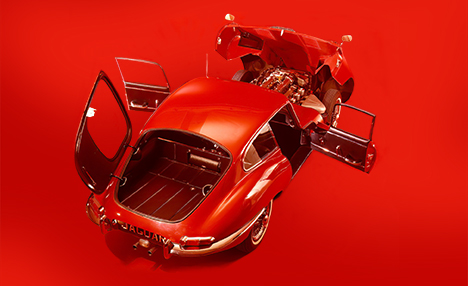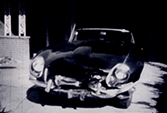The late 1950s imported car boom in America was fueled by dozens of mechanically interesting and unusual cars that were brought from all over the world. The most memorable and collectable examples were the sleek and powerful sports and luxury cars that came from Germany and England and the low production Italian exotics, though vast numbers of economical little transportation devices from Austin, Morris, Renault, Volkswagen, and Ford of England made their way to our shores.
Though cheap, cheerful, and filled to the brim with personality, the smaller imports became the domain of the truly artsy, the intellectual-beyond-words, the tragically hip, and the frugal to a fault. As used cars, they fell in stature to bottom-end high school transport and “clown cars” in the circus!
However, there was another class of European motorcar, the mid-sized sporting sedan, that was not imported in large numbers because, to the American mind and popular taste, their smaller size couldn’t justify their substantial price. Fine examples of good handling, peppy and well-appointed cars from Alfa-Romeo, Lancia, Riley, and MG were available to the select few that desired such a car—but at Olds and Buick prices. These were the BMW, Acura, and baby Mercedes of their day. Sort of pre-yuppie, yuppie cars! The concept of high-quality compact sedans would not be acceptable in the states for another 25 years.
This double drive concerns a rare pair from the British Motor Corporation. These cars were sold side by side in the same showrooms during the late ’50s. Both were developed during the merger of Austin of England and the Nuffield Group (Morris, Wolseley, Riley, and MG) to form the BMC late in 1951, and both were at least partially designed by well-known British automobile engineer Gerald Palmer.
Palmer had worked for Nuffield prior to WWII, where he styled the MG Y-Type sedan before moving to Jowett Cars to design their innovative Javelin. He returned to Nuffield in 1949 where his first project was the Y-Type’s successor, the MG Magnette, and its badge-engineered Wolseley counterpart.
These cars, like the lovely white ZA Magnette featured in this article, were well proportioned and traditionally appointed with lots of wood and leather inside a modern unit-constructed all-steel body fitted with contemporary brakes and suspension. Though ultimately put into production three years after the merger, these cars contained many of the old Nuffield designs and components. The early Wolseley versions even used the old underpowered (in this application) MG XPAG engine. The MG Magnette used the post-merger, Austin-derived B series, twin-carb, 1500cc unit, that was fitted to the first MGAs.
The Riley 1.5 was developed immediately after the merger and actually evolved from an attempt to update the popular Morris Minor. While Minor owners raved about their car’s torsion bar suspension and rack and pinion steering, the small engines, low gears, and mediocre brakes left a lot to be desired. BMC put Palmer to work on the task of getting the more powerful B series engine, bigger brakes, and more contemporary bodywork on the already state-of-the-art Minor floorpan.
Though Palmer did a number of designs and built one prototype, his plans were dashed when BMC management arrived one day with a stack of drawings based on Palmer’s prototype but finished by an Austin engineering staff. Palmer was told, “Here you are, we’ve designed the new Minor at our corporate office!” A disgruntled Palmer soon left for Vauxhall cars (GM of England).
Ironically, by the time the new design was being readied for production, the original Minor, now called the 1000, had received bigger brakes, more power, and higher gearing, and was enjoying a sales surge. BMC decided to move the new car upmarket with leather seating, wood interior appointments, a traditional upright grillwork, and present it as a small and nimble luxury sedan. Built both as the Riley 1.5 and the Wolseley 1500, these cars were touted as being perfect for use in urban areas and on tight, winding country roads.
The Riley version was the more sporting of the two and featured the same twin-carb four found in the MGA and Magnette, while the Wolseley 1500 used a detuned carb and featured less instrumentation. Only the Riley version was brought to North America. Since it sold for just $400 less than the latest Jaguar 2.4 sedan, not to mention powerful American competition, the Riley was not all that popular.
DRIVING THE RARE PAIR
The 1956 MG Magnette featured here was bought by Dan McCarthy of Santa Rosa, California, about eight years ago. Dan’s Magnette had been uprated in the power department when the previous owner fitted a 1800cc MGB engine from the late ’60s. Other than the later motor, the Magnette remains original, with new leather and a respray in Old English White.
The Riley 1.5 owned by John Voelcker of New York City, was found in a barn in Napa, California, in 1984. It is totally original, from the Clarendon Grey paint and red and white leather upholstery to its unworn fuzzy red carpeting. Bought from the widow of the original owner, the Riley had been sitting idle for over four years. It was then brought to San Francisco, where John was living at the time, and cleaned and detailed within a inch of its life! Since detailing, the car has placed in Concours at Palo Alto and Lafayette, California.
Both cars arc quite similar in many ways, yet quite different in feel. Since the cars share the same basic engine, transmission, SU fuel delivery system, and Lucas electrics, they start, sound, and work much the same. The Magnette is bigger both inside and out and really feels like an early post-war British luxury car. The dash and window silk are high and there’s wood everywhere. The leather seats are wide and comfortable and the back seat is big enough for three people. The body is similar in line to an early Jaguar Mark IV or an S1 Bentley. There’s not much chrome to muck up the classic lines, though more brightwork and two-tone paints showed up on the later model—the ZB Varitone.
In contrast, the Riley has all the bad and good points it inherited from the Morris Minor. Because it was built on the Minor’s 86″ wheelbase, it is a short four-passenger car with limited rear leg room. The wood dashboard is well laid out and fully instrumented, but the rest of the wood looks as though it was added as an afterthought! The two-tone leather might have been the bee’s knees in 1958, but would be better suited to a car with massive tail fins. On the credit side, all the controls fall easily to hand, the seating and bucket scats feel excellent, and visibility is superb.
The car is a “newer” car than the Magnette, and if one can come to grips with the British interpretation of late ’50s American styling and view it as “cute” or at least “period” (as one does with triangular or kidney-shaped coffee tables!), the interior becomes acceptable. Outside, the car is almost majestic in trim and detail but becomes almost cartoon-like when all those fine elements are squeezed onto the Riley’s stubby little body. It’s all a matter of taste—and this one sure tastes different!
Once on the road, the cars change position. While the stately MG rides like a proper luxury cruiser, it steers and handles like a truck! Even the bigger MGB mill can’t compensate for its weight and heavy steering. Stop-and-go driving around town is a chore, with constant shifting and limited maneuverability.The Magnette is more akin to a ’54 Plymouth than any sports car in this situation. Once you get the Magnette on country roads, its MG heritage shines through, and freeway driving is smooth and relaxed.
In contrast, the Riley is a rocket! It will keep up with, or blow away, many of the latest offerings from the far side of the Pacific, and it nips in and out of traffic like a motorcycle. The rack and pinion steering and torsion bar suspension are still fully acceptable in today’s traffic, and the car is immensely entertaining to drive. Mountain roads are an absolute kick as the modern Michelin tires grip the asphalt and the little Jello-mold of a car leans into the corners. The Riley inherited some of the Minor’s rear wheel hop when accelerating into corners, but a careful foot can modulate most of it down to a minimum. On the freeway, the short wheelbase makes for a choppy motion on tar strips, but most of the time the ride is satisfactory. The 3.70 rear end gears will allow you to blast along in the fast lane at a sustained 85 mph and push late-model Bimmers out of the way. The look on the passed driver’s face is worth the price of admission. Wa-hoo!
CONCLUSIONS
These are cars that appeal to different people. If one is looking for a classy little classic that has a recognized pedigree, and has little intention of using the car in an urban environment, then the Magnette is your baby. The lack of outright performance is offset by nice lines and a smooth ride.
If you don’t mind some odd angles and ’50s styling mixed with your traditional design details, and want a zippy little sports sedan that feels like a predecessor to a 3 series BMW, the Riley’s for you. On today’s market, the Riley is less expensive but harder to find. “So ya pays yer money and takes yer choice!”
—Rich Teibusch
(Rick Teibusch is based in Venice, California, and organizes the British Car Meets in The Golden State. He also writes for numerous automobile magazines, including covering the American scene for the BBC’s “Top Gear” magazine and “Classic Cars.”)







'The MG Magnette' has no comments
Be the first to comment this post!